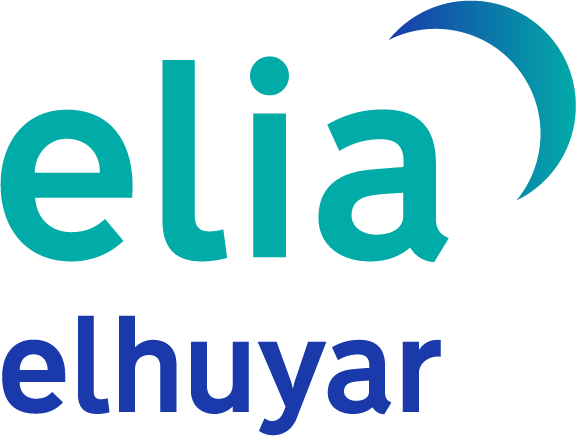Introduction
Artificial Intelligence (IC) appears among the topics of fashion and marks the beginning of the so-called fourth digital revolution. The development of algorithmic models and the dramatic rise of Big Data or massive digitalized data have allowed us to advance in a highly technological context in the first two decades of the 21st century. Within this framework of opportunities and challenges, the media have started to pay attention to AA, becoming an original source of information about this phenomenon for many citizens (Sun et al, 2020). Strategy changes are taking place within media companies themselves and companies have long seen their legitimacy and information capacity to address broadcasters on social media such as X, Tik Tok or Instagram.
The need to compete in a context of growing public interest has led media companies to change their strategies (Brenn, Howard and Nielsen, 2018). On the one hand, the agenda of topics of impact and popular character has been prioritized in view of the topics of scientific and technological journalism. On the other hand, many mainstream media have not yet found effective strategies to transfer their activity to social media and attract audience attention using words from traol, quotes and other specific functions of these platforms. Among them, X (formerly Twitter) has been one of the most effective so far to disseminate the media message beyond paper or audiovisual or cybermedia support and to foster digital public debate and dialogue on important issues.
Studies on the role of the media in public access to information on AEs are still scarce. The New York Times, Washington Post, The Guardian, and USA Today al.ek, from its inception over four decades to the present day, have been analyzed. Brennen, Howard and Nielsen (2018) have analysed AA information in nearly eight hundred news reports from the six most prominent media in the UK. According to this paper, conservative media focus on issues related to the economy and geopolitics, addressing issues such as automation, national security and investment. On the other hand, progressive media prioritize ethical issues related to artificial intelligence, analyzing aspects such as discrimination, algorithmic landfill or privacy. The same work addresses issues such as the lack of agreement on AA, its regulation and social integration.
In more limited areas such as Euskal Herria, AA has a prominent presence in traditional offline media (television news, weekend magazines, radio debates, etc. ). It is also the subject of informal and professional social conversations. In this sense, it is enough to recall the meetings held by the College of Basque Journalists (2023a and 2023b) during the year 2023 between academics and communication experts. Considering that there is no study on OA coverage in the media in the Basque Country, this text presents the results of an initial exploration on this subject.
Methodology
This study analyzes the discourse on OA in platform X of the main aspects of the general, specialized media and institutions of higher education, science and technology of the Basque Country (Table 1). This general objective has been translated into a series of specific themes (activity and language, topics and words of traol, mentions, engagement) that are detailed below. The study sample consists of 21 x accounts (formerly Twitter). Of these, 13 correspond to the general media of press, radio and television, 2 to the most specialized media and scientific-technological development and 6 to the higher education institutions, scientific, social and cultural transfer and dissemination, all with visibility and recognition among Basque citizens.
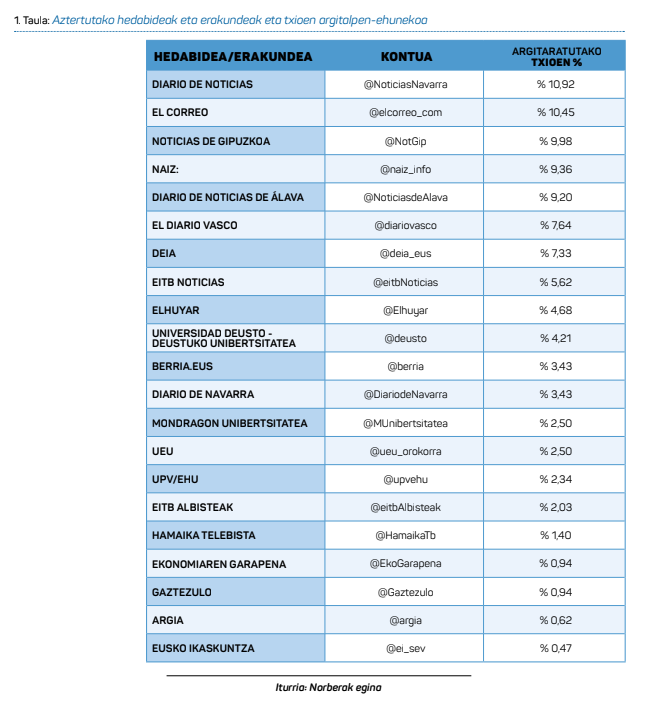
The analysis has considered a broad time frame from 2009 to December 2023. In 2009, the first txio was detected in the field of the media considered, Argia (“Artificial Intelligence. Machines of the future with or without company”, 16/10/2009). The study has also paid special attention to the evolution of the coverage of OA by the Basque media throughout 2023, taking into account the rise of the issue, as shown in Figure 1. In total, 641 AI tweets published between 2009 and 2023 were analyzed in 21 X accounts (formerly Twitter) of the study. The scrapping tool Zeeschuimer (Peeters, 2023) was used to obtain and download these tweets.
As already indicated, the study has taken into account specific aspects when analyzing the transfer of content on Artificial Intelligence to society from digital dialogue: on the one hand, the level of activity of the accounts in the dissemination and promotion of themes related to Artificial Intelligence in the Basque Country (RQ1) has been analyzed, and on the other hand, the degree of relationship between the words tracoloras (3) and the discussion has been analyzed. A REGEX search pattern in Python programming language (Welcome to Python.Org, 2023) has been used to extract the words inserted in the text of the messages. Subsequently, the graph of relations between media and institutions and their corresponding hashtag words has been worked on the Gephi visualizer (Bastian et al., 2009). Community detection was performed using the Louvain algorithm (Blondel et al., 2008).
The Engagement metric is built from: “the weighting of returns, responses and leases, taking into account the increasing level of cognitive involvement, exposure and vulnerability (in terms of visibility in the personal network) of these activities” (Coursaris et al., 2014). As reflected in the following formula:
3(no revolutions) + 2(no answers) + 1.5(no likes)total account followers

To address themes and interviews, a label category list (Table 2) was created, of great interest to classify the chickens in the sample by themes (n = 641).

Finally, and taking into account Tik Tok"s interest in the drafting of these lines, a survey was conducted on how AA is working on this platform, trying to focus the analysis on the degree of presence of this topic in the digital dialogue and interaction, starting from the term #Artificial Intelligence. As will be discussed below, there have been limited data. This is a consequence of two main factors. On the one hand, the lower presence of the agents analyzed in this social network: Of the 21 media and institutions with X presence, only 7 media and one educational institution manage the accounts on the Tik Tok platform (El Correo, El Diario Vasco, Diario de Noticias, Diario de Navarra, Argia, Gaztezulo, EITB and the University of Deusto). This circumstance has a special impact on the media entirely in Basque. On the other hand, the dispersion of contents in Basque related to Artificial Intelligence is due to the users" use of other hashtag words such as #AI or #IA, which greatly hinders their recovery.
RESULTS
In the last fourteen years, the reference of Artificial Intelligence as a fashionable term or expression shows that the impact or interest is scarce in the themes of the general media, specialized and institutions considered in the study (RQ1) (Figure 1).
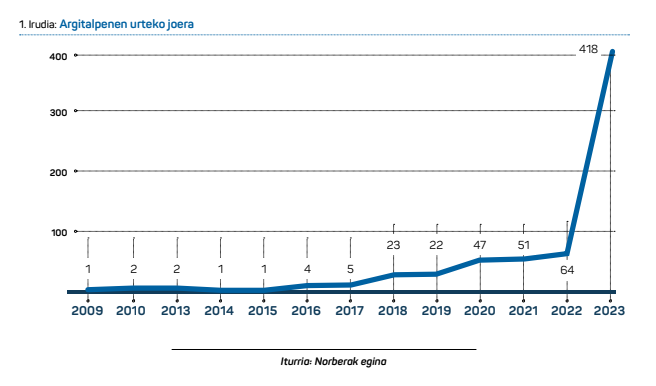
Since 2018 there has been a certain reflection of the global impact of AA as a seasonal issue, especially in the last year. In relation to this evolution over 2023 (Graph 2), it is observed that it is very stable and responds to certain milestones associated with AA, such as the evolution in the versions of the OpenAI AA creator Chat GPT or other imaging services (RQ1).
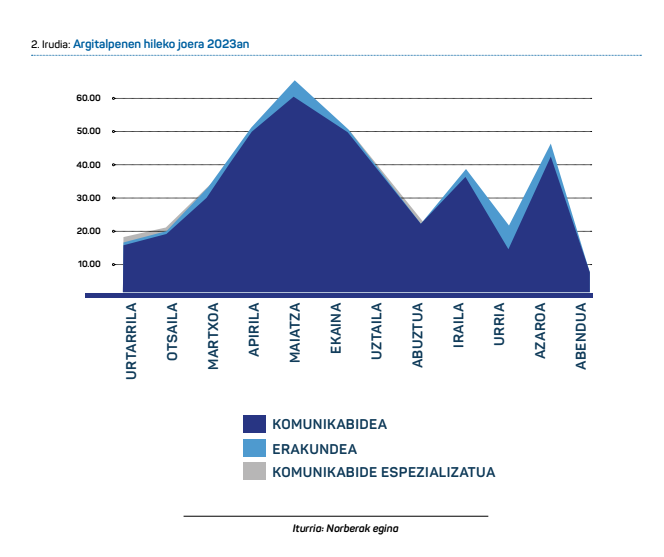
Specialized media (Light and Economic Development) have only 3 publications in 2023 (January, February and July), which prevents the detection of specific activity trends (Figure 2). Taking into account the historical publications, the journal Argia has 1 endowment in 2009, 1 in 2020 and 2 in 2023. Economic Development has 2 in 2019, 1 in 2020, 1 in 2021, 1 in 2022 and 1 in 2023. 10 publications in total.
As for linguistic uses (RQ2), the number of tweets in Spanish is 87.03% and the number of tweets in Basque is 18.97% (Table 3). Regarding the media information related to the languages used, 72.10% of the content was generated in Spanish and only 10.66% in Basque. In the case of organisations, despite their lower representativeness, representing only 17.71% of total tweets, a balance is observed in the use of the two languages: 8.93% in Spanish and 8.78% in Basque.

As for the publication in Basque of the generalist media, Naiz is the bilingual medium that most broadcasts AA themes. The following is Deia, which presents 2 of the 47 Basque publications. The Naiz newspaper produces 9.92% of the Basque language publications and 85.71% of the bilingual media publications. If the @eitbNews account is included within this group, the percentage is reduced to 35.29%. Regarding monolingual issues in Euskera, the largest activity corresponds to a specialized source, the @Elhuyar account, followed by @Berria as a generalist medium (Table 4).
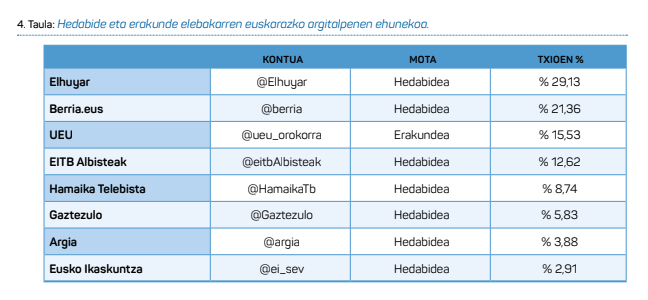
Regarding the main classifications and themes around the AA (RQ3) (Table 5), it is noted that X is mainly used as a multi-platform objective, i.e. to publicize the information and content hosted on other digital platforms, in general on the web or in the cybermedia. Thus, there is no interest in differentiating and deepening current AA typologies or developments (simple automation, natural language processing, Machine Learning, etc.). ). The aspects analysed focus mainly on the practical applications of AA (20.90%) and innovation and novelties (19.81%) and on presenting controversial or popular themes, motivated mainly by reasons related to the impact of AA on the economy – professional development – and culture. A more detailed analysis of the central theme (practical applications) shows that they focus mainly on health and business issues (Table 6).
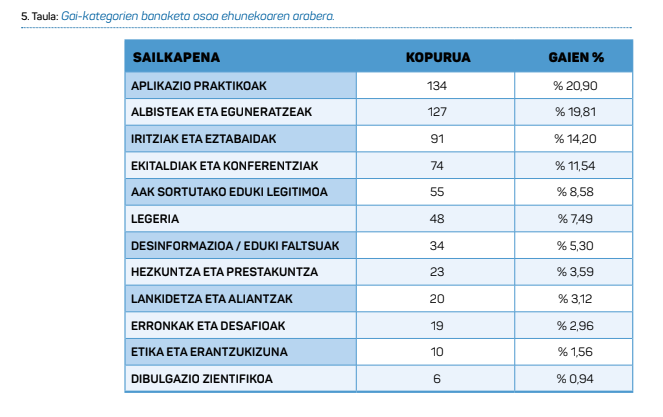
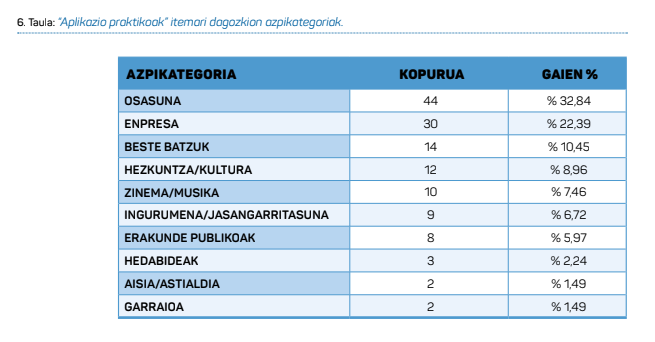
Regarding the classification of the controversy by Tracolonic Words (RQ3), among the fifty traolated words considered, the #artificial intelligence has been the most widely used, as it has been used 21 times (Table 7). After this use the words of traol related to specific applications of recognized prestige, such as #chatgpt, used 17 times. The other words associated with the digital dialogue on AA in which the analyzed accounts have participated have to do with generalist terminology in different languages (ai, ia, artificial intelligence, artificial intelligence…) and, although to a lesser extent, represent just under 2% in each case, themes related to the current technological phenomenon such as robot, deeplearning, #chbotsamading, #realsamaldata, machinpelan.

A tripartite network of quotations is formed around the term ‘Artificial’ (Figure 3), linked to the teaching institutions University of Deusto and Mondragon Unibertsitatea and the economic development organization of the Basque Government. ‘Artificial intelligence’ is also related to the Daily News Media of Álava and Deia. The UPV/EHU also includes ‘almost’. In this network node we find the word ‘chatgpt’ associated with the same operators.
In the Basque version, the term ‘artificial intelligence’ is mainly used by the Basque Summer University and Hamaika Telebista. In this network area there is no other AA reference. The term ‘ChatGPT’ relates Elhuyar to El Correo, which includes ‘robot’ and ‘SamAltman’, referring to the CEO of OpenAI. The public body EITB does not receive in either of its two accounts the words of tracol on AA (eitbNews and eitbNews), and the same happens in the case of Berria, El Diario Vasco, Diario de Noticias, Naiz and Diario de Noticias de Álava, Gaztezulo or Eusko Ikaskuntza. The journal Argia and the journal of Navarra have not used hashtag words to refer to publications on AA.
The Artificial Intelligence nomenclature, that is, the words #AI, connects Mondragon Unibertsitatea with the University of Deusto. This organization is the media and institutional agent that uses more words from specific AA trades (‘DeepLearning’, ‘CaixabankIntellinge’, ‘MachineLearning’, ‘chatbots’ or ‘Virtual Reality’). Sherpa AI is cited by the media El Correo and EITB Noticias.

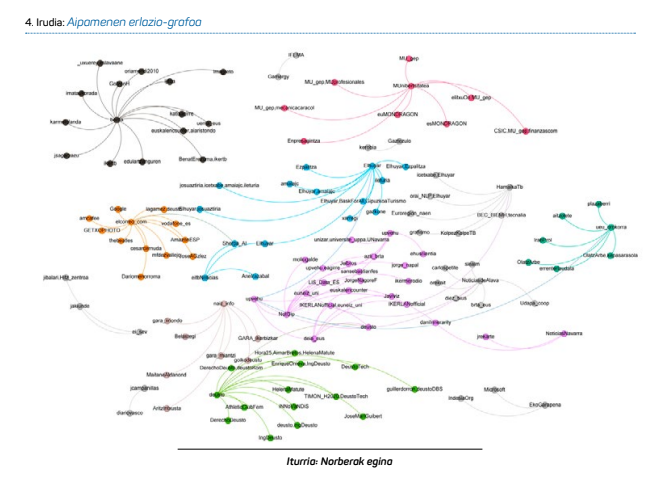
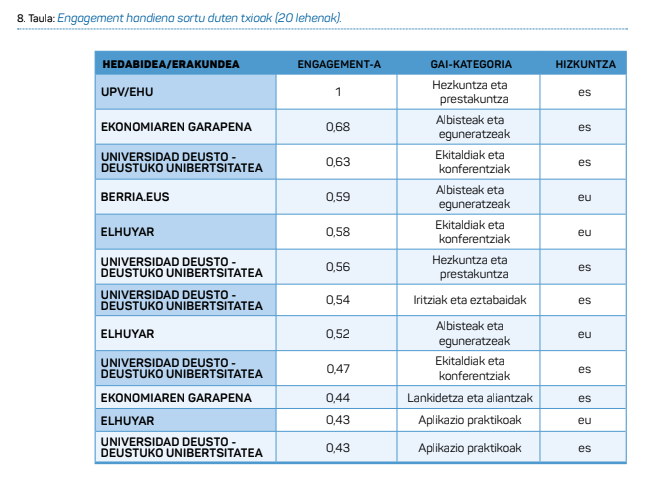
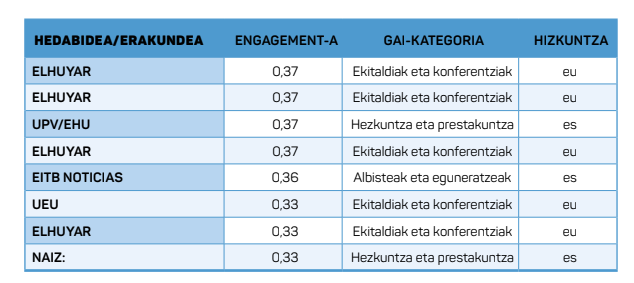
The data obtained in the form of chips, replicas and lichens highlight the really poor engagement metrics (Table 9), even at specific times related to controversial issues such as the use of images by the AA or the risks it may have in promoting Deepfake. In fact, the tweeting that has had the most viral things are not associated with controversial data, but with developments or implantations of AA with educational and economic impact.
As in the case of data extracted from X, the Zeeschuimer tool was used for the prospection of Tik Tok. For search terms, the words hashtag #artificial intelligence and #artificial intelligence were used and five videos corresponding to @gaizka_izagirre, @bizkaiatechmagazine,@amaurre.steam; @burutyle and @zeroetabat were obtained. These videos focus on AA related outreach work: a conference linked to Elhuyar, a news article, a STEAM project, an expert meeting and a podcast, respectively.
CONCLUSIONS
Despite its growing scientific, economic, cultural and social interest, public understanding of the technological phenomenon associated with artificial intelligence currently requires a greater general digital literacy of the population. In this sense, the study offers a fixed photograph of the limited scope currently shown by the main sources of reference that Basque citizens can use in the search for information about what artificial intelligence is. This photograph may be of interest considering the recent publication of some thematic coverage studies from other European countries.
The dissemination of AA-related issues does not show a far-reaching information strategy, beyond the exploitation of X (formerly Twitter) as an additional channel for dissemination and the use of certain words of traol more or less common to all media.
Except in the case of the media and the specific scientific issues of the educational field in Basque, there is also a small effort for the dissemination in Basque of this increasingly attractive public-media theme. Similarly, it is evident that the theme of OA has been little used to create engagement and networks of digital relations between different nodes representative of Basque culture and science, such as those representing the accounts analyzed.
As for the content, in general, the information analyzed in this work presents OA as a viable solution to the everyday problems of everyday life (health, economy, etc.) and attests to its status as a high-potential emerging technology.
In short, the media and the issues specialized in the technology-digital field do not use the advantages of platform X to disseminate a broad knowledge about OA and its specific social and economic implications for the context of the Basque Country, so they miss an interesting opportunity to generate knowledge dissemination and transfer for social purposes at a time of great need. The transmission of the debate to the social media and the possibility that the generalist, specialized and relevant or legitimized institutions can dynamize it would certainly be very useful to build bridges between conversations about the AA that allow a more enriching public dialogue in the Basque Country. This territory has scientists, activists and other agents of great interest that can offer alternative and independent views on the capabilities, interventions and risks associated with OA. This concept would be of great help in explaining that AA is not a mere catastrophic disruption (Craig, 2018), but a set of new and effective evolving technologies that can contribute to the strengthening of Basque society and its developments.
Moreover, the current limitations of this study encourage a second phase to promote a more detailed analysis of the specific content of NN information. It is expected that future prospects similar to those collected in this study will provide more significant data in quantitative terms, but above all in qualitative terms, which will allow the visualization on social media networks of more ordered, strategic, viral and social media, responding to the informative and educational role that Basque citizenship demands from the media and institutions, as well as from the social media. The AA shows a great capacity for transformation in different professional areas, as well as a strong ethical and legal involvement. It can therefore be important to have high-quality information that encourages intense and critical public debate. It should also be taken into account that the way the media address OA coverage can have a significant impact on people’s perceptions and responses around this technology.
REFERENCES
Arana, Edorta; Narbaiza, Bea; Sánchez, Garazi; Zorita, Itziar; Goirizelaia, Maialen (2023): Youth and information. IKUSIKER Audiovisual Observatory.
Labastian, M., Heymann, S., & Jacomy, M. (2009). Gephi: An open source software for exploring and manipulating networks. Proceedings of the international AAAI conference on web and social media, 3(1), 361-362. http://ojs.aaai.org/index.php/ICWSM/article/view/13937
Blondel, V. D. Guillaume, J.-L., Lambiotte, R. & Lefebvre, E. (2008). Communication in large networks. Journal of statistical mechanics: theory and experimental, 2008(10), P10008.
Brennen, J., Howard P.; Nielsen, R. (2018). “An Industry-Led Debate: How UK Media Cover Artificial Intelligence”. Oxford: Reuters Institute. https://reutersinstitute.politics.ox.ac.uk/sites/default/files/2018-12/Brennen_UK_Media_Coverage_of_AI_FINAL.pdf
Coursaris, C. K., van Osch, W., Brooks, B. (2014). Social Media Marketing on Twitter. F. F.-H. Nah (Ed. ), HCI in Business (pp. 155-165). Springer International Publishing. https://doi.org/10.1007/978-3-319-07293-7_15
Association of Basque Journalists (2023b). Artificial Intelligence and Humanism. Bilbao, 31 May. https://kazetariak.eus
Association of Basque Journalists (2023b). Artificial Intelligence. Challenges. Bilbao, 12 December. https://kazetariak.eus/inteligencia-artificial-oportunidades-y-desafios/
Peeters, S. (2023). Zeeschuimer (v1.8.0) [Software]. Zenodo. https://doi.org/10.5281/zenodo.10231811
Python.org. (2023, 15 December). Welcome to Python. https://www.python.org/
Sun, S., Zhai, Y. Shen, B., & Chen, Y. (2020). Newspaper coverage of artificial intelligence: Emerging technologies. Telematics and Informatics, 53.
Note
This work is part of the academic production of the Research Group of the Basque University System GUREIKER (IT1496-22).


